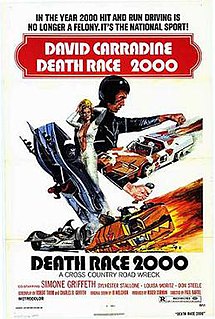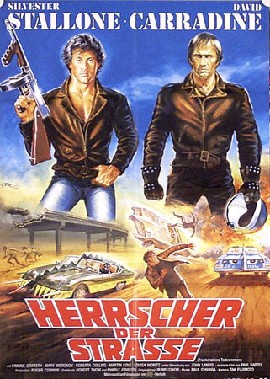Death Race 2000 takes place in the futuristic year of 2000, after a world financial collapse has turned the USA into the dystopian United Provinces of America, a military/religion/media based dictatorship ran by the smarmy Mr. President. To calm and entertain the masses, the government started a new national sporting event, the annual Transcontinental Road Race, which is a crazy vehicular cross country race where the drivers are awarded points for hit and run murders.
The drivers (along with their navigators) each have their own gimmick. There's rough and tumble cowgirl Calamity Jane (Mary Woronov), gladiatorial Nero the Hero (Martin Kove), female Nazi Mathilda the Hun (Roberta Collins), Italian mobster-type Machine Gun Joe Viturbo (Sylvester Stallone), and the favorite to win the race, by both the fans and the government, Frankenstein (David Carradine), the only previous two-time winner of the Death Race.
Frankenstein wears an all black outfit, is said to be scarred up and stitched together, and has a mythical-hero status amongst the fans. He's depicted as a champion and survivor. This is, of course, all bullshit, as his new navigator Annie Smith (Simone Griffeth) finds out first hand. Annie though, has her own secrets. She's part of a resistance force, led by the patriotic Thomasina Paine (yes, great-granddaughter of Thomas Paine) that has taken it upon themselves to disrupt, sabotage, and stop the Transcontinental Road Race in an effort to restore American freedom and democracy to the people (or something like that; their plan and intended results are never made quite clear).
This is a violent film, very bloody at times, but usually done in a comical way. People are sometimes gouged in the crotch with car mounted knives (it's funny, I swear) or get ran over when they peak out of manhole covers. Calamity Jane (with her bull designed car) has a showdown with a bullfighter. There's even a bomb disguised as a baby. This bloody mayhem is always accompanied by a gleeful sense of playfulness, with the occasional cartoon sound effect or sight gag, such as when one driver speeds their car off a cliff, fooled by a fake tunnel (à la Wily E. Coyote) or later, when the rather useful "hand grenade" is deployed.
The excessive (and cartoony) violence depicted in Death Race 2000 only further underlines its satire and critique on American obsession with mayhem as entertainment. These satirical elements are personified by the shrill and pandering media, consisting of the fake (but aptly named) Grace Pander (Joyce Jameson, who is "a dear friend of mine"), Howard Cosell-soundalike Harold, and the annoyingly upbeat Junior Bruce (The Real Don Steele). These three bozos gleefully comment on all the carnage and action during the race (as filtered through the government) and sound like a combination of sportscasters and info-tainment news reporters. In addition, they broadcast the xenophobic messages of the government (the French are blamed for the attacks against the racers) to help distract the public from domestic issues and further public devotion to their reality television programming. (Any of this sounding vaguely familiar?)
Since we are talking about a Roger Corman production, it should go without saying that the movie is, on occasion, cheap looking. There's an obvious matte painting (see above) depicting the future world that is far from convincing and a few of the sets look questionable, while some costumes appear ill-fitting. The race cars themselves look like they could fall apart at any moment, which was true, as they were mostly made from remodeled Volkswagens overlaid with fiberglass bodies. Each vehicle had its own design that matched the driver, like Machine Gun Joe with his tommy-gun mounted car, or Calamity Jane with her car that resembles a bull (the horns come in handy). The cheapness of things only adds to the overall charm, giving the movie that "only-in-the-1970s" feel. Given the limitations of the production and what, on paper, might seem like a movie that shouldn't work, Death Race 2000 plays amazingly well, with a fast pace, wicked sense of humor, and a seriousness that rarely falters in the face of ridiculousness. It's a movie that hits on all cylinders, never failing to entertain.
The absurdist elements and humor in the film can be attributed to director Paul Bartel, who also has a small cameo as a doctor. He has a strange, fey humor and brings a deadpan seriousness to all of the outlandishness of the story. Bartel also directed the bizarre horror film Private Parts (1972) and the well reviewed Eating Raoul (1982), in which he starred along with Mary Woronov. He has a very distinct manner (and beard) and can also be seen in Piranha (1978), European Vacation (1985), and Gremlins 2: The New Batch (1990).
Bartel had assistance from his second unit crew (led by writer Charles B. Griffith) in shooting some of the driving and action sequences, and Roger Corman wanted there to be more blood, so he brought in Lewis Teague (future director of Alligator [1980], Cujo [1983], and Cat's Eye [1985]) to shoot some additional gore and bloody insert shots of people getting killed by the cars. Team effort guys, the Corman way!
Cinematographer Tak Fujimoto would start his career with Terrence Malick's beautiful Badlands (1973) and then follow that with a stint working on mostly B-movies, before hitting a stride with 80s classics Pretty in Pink, Something Wild, and Ferris Bueller's Day Off (all 1986), and mainstream favorites that include The Silence of the Lambs (1991), Philadelphia (1993), and The Sixth Sense (1999).
The screenplay was written by Charles B. Griffith and Robert Thom. Griffith has a long list of Corman collaborations, including Attack of the Crab Monsters (1957), A Bucket of Blood (1959), Little Shop of Horrors (1960), and The Wild Angels (1966), while Thom's only other significant credited work is a non-Corman production, the psychological incest-revenge film, The Witch Who Came from the Sea (1976).
Sly Stallone plays a good Italian tough guy and eats up his villainous role. He's really fun and is given some of the best lines ("I got two words to say to that: BULL-SHIT!"). The year after Death Race 2000, Stallone would get (justifiably) great reviews for writing and starring in Rocky, setting the stage for his subsequent success and stardom.
This was David Carradine's first movie role after leaving the TV series Kung-Fu, and he plays it cool as the smooth and smart-assed Frankenstein. He displays a mysterious smugness that accentuates his sex appeal, maybe best described after he removes his mask and asks, "What did you expect? Another pretty face?" Carradine refused to wear leather (he was very much a hippie) and his costume was made out of a stretchy, leather-like fabric. David Carradine would go on to face-off against a giant flying lizard in Q: The Winged Serpent (1982), Chuck Norris in Lone Wolf McQuade (1983), and with Uma Thurman in Kill Bill Vol. 1 and 2 (2003/04).
Mary Woronov was a product of the Andy Warhol factory and is a cult favorite actress. She bites into her role as Calamity Jane, giving her a loud, snarky orneriness. Woronov would go on to star in Eating Raoul, Night of the Comet (1984), TerrorVision (1986), and House of the Devil (2009).
Roberta Collins starred alongside Pam Grier in the women-in-prison films The Big Doll House and Women in Cages (both 1971), as well as Jonathan Demme's take on the genre/directorial debut, Caged Heat (1974). She was also in Matt Cimber's The Witch Who Came from the Sea and Tobe Hooper's Eaten Alive (1977).
Martin Kove is best known as the evil leader of the Cobra Kai dojo in The Karate Kid movies, but horror fans also know him as one of the dopey cops in Wes Craven's The Last House on the Left (1973). His navigator, Cleopatra, is played by Leslie McRay, who is recognizable to fans of MST3k as the titular star of The Girl in Gold Boots (1968).
The overly eager announcer Junior Bruce was played by popular and local LA disc jockey The Real Don Steele, who was in a few other Roger Corman productions, including Grand Theft Auto (1977) and Rock and Roll High School (1979). He is also featured (voice only) as radio disc jockey Rockin' Ricky Rialto in 1984's Gremlins.
Death Race 2000 was remade in 2008 (simply titled Death Race). The remake has spawned two direct-to-DVD sequels and I've not seen any of these (supposedly horrid) movies, so I can't say anything about them. I know the remake stars Jason Statham and they ditch the hit-and-run aspect of the story, which sounds shitty and like it defeats the purpose...so ......stick with the original, real deal and accept no substitutes.
Remember: Women are worth 10+ points in all categories. Teens rack-up 40 points and toddlers (under 12) are worth a big 70. And anybody over the age of 75 is worth a whopping 100 points.
*note: Lots of squealing tires in this movie. None of them on dirt.














No comments:
Post a Comment